Q&A – Ask Neil: January 9, 2025
(Please read these instructions carefully.)
Before you post your question, please look at recent issues to see if someone else has already asked it. You might find your answer there.
How to submit your question…
(Note: You may need to allow a pop-up window to come up in order to get the link for sending your photo(s). If you have already submitted your question and didn’t see the pop-up window, please click here.)
• Click the link provided below to post your question. After you submit your question, a new window will pop up giving you the address to which you can e-mail a SHARP, HIGH-RESOLUTION PHOTO to accompany your question. Please DO NOT SEND THUMBNAIL PHOTOS in case I need to zoom in to see things.
• Click here to post your question.
• Please ONLY POST YOUR QUESTION ONE TIME. We can only accept a set number of questions each week, and when we get duplicates it costs other people their chances.
• One question per reader, please.
• Please use this only for posting questions – not for standard emails.
• Watch for your answer in the following week’s e-gardens.
• I choose those of greatest general interest. For example, plant IDs seldom make the cut.
• I must have your first name or initials.
• I must have your city or county. (Texas is a very large state.)
QUESTION 1
CAN MY JUNIPER BE SAVED?
Question: There is definitely something wrong with my juniper. The affected branches need to be pruned out, but can the plant be saved? T. N., Parker, Collin County.
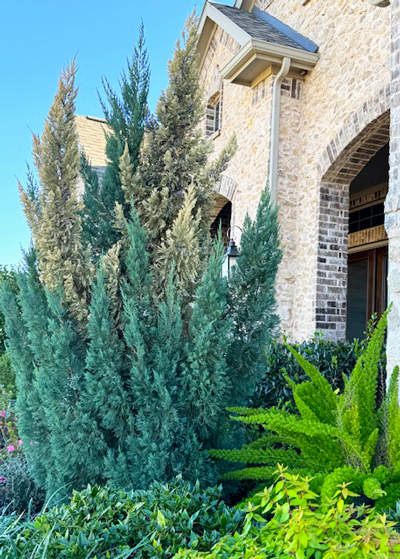
Answer: This is a twig blight that is very common on many cultivars of juniper. I see it frequently on Blue Point and Spartan junipers, two of our most popular upright selections. Unfortunately, by the time you prune it out the plant is usually so disfigured that there isn’t much left worth saving. Do a Web search for Phomopsis and Kabatina twig blights on junipers and you’ll find many useful matches from all over the country. Here are a few from respected universities:
Morton Arboretum (for purposes of photos)
I see this quite often. In fact, I lost my own two Spartans to it. Sadly, there is no spray to stop it.
You might find Oakland hollies to be suitable replacement shrubs with similar height and width. I wish I had better news for you.
On the question you didn’t ask: I surely hope you got your foxtail fern into protection from all the cold.
QUESTION 2
WOULD ‘WHITEWATER’ WEEPING REDBUD DO WELL IN OUR AREA?
Question: I’m considering planting a ‘Whitewater’ weeping redbud. Would it do well in our area? Can I plant it in a bed in full sun close to the house or would it get too large? Gay H., Hurst.
Answer: There is such a big group of redbud cultivars coming into the marketplaces – it’s a great time to be a lover of this super tree.
I have not grown ‘Whitewater’ so I decided to do a little research. One of the best sources of plant information is always the North Carolina State University website, and wouldn’t you know: ‘Whitewater’ was developed by Dr. Dennis Werner of NCSU, so we are going straight to the source.
Here is what they have to say:
“This plant requires full sun to partial shade. It is at its best in full sun but benefits from some afternoon shade in hot climates. It prefers to grow in average to moist conditions and shouldn’t be allowed to dry out.”
Compared to North Carolina, we would definitely qualify as being a “hot climate.” You would want to plant it where it would have shade in the afternoon. It can get very hot against masonry walls.
Relative to its size, they say it grows to 6 ft. tall and 2 to 3 ft. wide, so as long as you have it 4 or 5 ft. out from the house you should be fine. (6-7 ft. would probably look better.)
QUESTION 3
WHAT IS THE BLACK AT THE BOTTOM OF OUR LACEBARK ELM? ALSO WHY ARE OUR PECANS ALWAYS SHRIVELED UP INSIDE?
Question: I have attached a photo of our lacebark elm. What is the black at its base? We also have two pecans (don’t know the variety). The meat is always shriveled up inside. Is there anything I can do to correct that? Ann L., Forney.
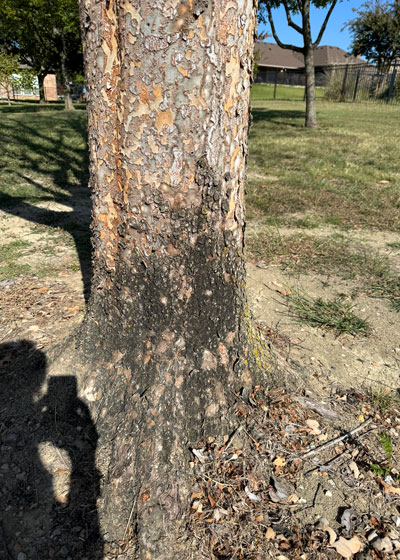
Answer: Usually, black bark indicates mold and decay within a trunk. I normally look for a crack with weeping moisture. In the photo that may be the line coming down the left side of your tree’s trunk, although I might have expected the black to be more concentrated at its terminus. Lacebark elms don’t have particularly hard wood, so the trunk could be compromised. I would recommend having a certified arborist inspect the tree closely. It’s not a job for an amateur or rookie tree person. You would want someone with experience with this species.
As for the pecans, that is probably due to late-season drought. Pecan kernels fill out in late summer going into early fall. If it’s hot and dry, and if supplemetal irrigation is not given to the trees, the kernels will fail to fill out. You’ll notice on this long list of potential problems that Dr. McEachern chose to put it in the top position.
QUESTION 4
SHOULD I HAVE WAITED TO PLANT MY MAGNOLIAS?
Question: My daughter bought me two southern magnolias for Christmas. They are about 7 ft. tall. They are rootbound in their pots from the nursery. She was instructed to get them in the ground ASAP, but with the upcoming freeze, should I wait? Jennifer F., Paris.
Answer: To keep it fresh and timely, I prepare each week’s e-gardens a day or two before we distribute it on Thursdays. I’m seeing your question for the first time on Tuesday evening at 11:30 p.m., and for that I’m really sorry. For future reference, immediate questions are better directed to my radio programs over the weekend or to a local independent garden center. My answer would have been to do what the nursery suggested. You lose about 20 degrees’ worth of hardiness when you leave a plant in a container above ground. Hopefully, if you didn’t go ahead and plant the trees you did water them well. Odds are that they will pull through without damage. You’ll be able to tell within a few days.
QUESTION 5
WHAT IS THE BEST PLACEMENT, DIRECTION FOR A GREENHOUSE?
Question: I’m considering getting a greenhouse, but I need to know where would be the best place, direction to install it. Rose J., Grayson County.
Answer: Hopefully it will be medium-sized (10×20 ft.) or larger. Small greenhouses are really difficult to manage temperature-wise. They can overheat so rapidly, even on cold mornings in the winter. The smaller it is, the more critical it is that you have afternoon shade, even in spring and fall. I prefer an east side with a shade tree or building to the west. You’ll want good ventilation with a vent on one end and an exhaust fan on the other. I have a larger greenhouse, and even with it I find it easiest to leave my nursery shade fabric in place year ‘round. Keep doing your homework. Greenhouses are great fun, especially if they’re well planned ahead of construction.
QUESTION 6
WHAT IS ATTACKING MY CITRUS TREES?
Question: What is attacking my citrus trees in my greenhouse? Jim I., Chandler, Henderson County.
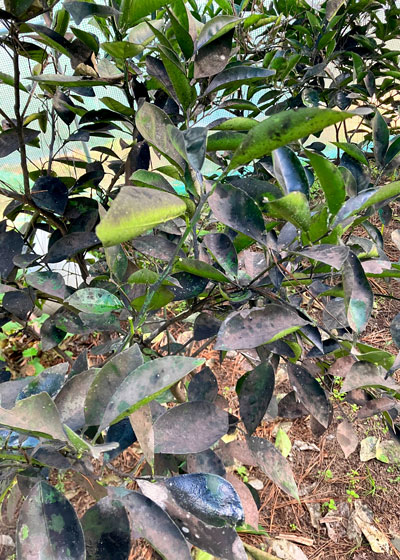
Answer: Whiteflies. If you tap one of their stems you’ll probably see the adult insects flying around. They secrete a sticky honeydew that is basically sap they have sucked from the plants’ leaves. Sooty mold fungus grows in that honeydew. To control the sooty mold you must eliminate the whiteflies. I wish it were as easy to do as it is to type. They are prolific in fast order. Let a Texas Certified Nursery Professional show you the products they sell for whiteflies, and be prepared to spray every week for several months. You can see the eggs attached to the backs of the leaves in your photo, so there are always new ones coming along. As the leaves drop off new ones will be free of the mold, but you’ll want to get rid of the old leaves to eliminate the inoculum. The whiteflies are likely to spread to other plants in your greenhouse. They are one of the most obnoxious pests you can get. Not the most damaging. Just super-disgusting.
QUESTION 7
WHAT SHRUBS WOULD YOU SUGGEST FOR OUR LANDSCAPE?
Question: I went to your one-day landscaping school years ago. It was very helpful in landscaping our former house. We have built a smaller house between Boyd and Decatur and I need suggestions on evergreen shrubs on these two sides. There are trees everywhere but not in the yard. The front faces east and the carport faces south. Thanks for any suggestions. Joyce. Wise County.
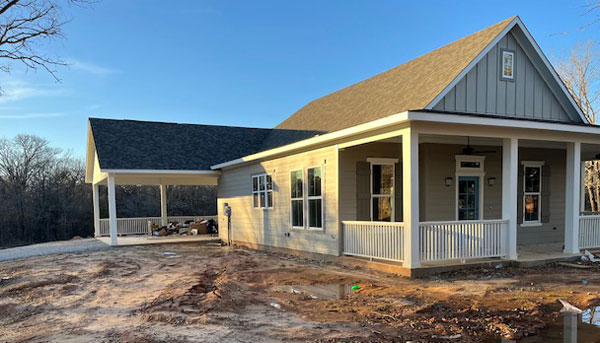
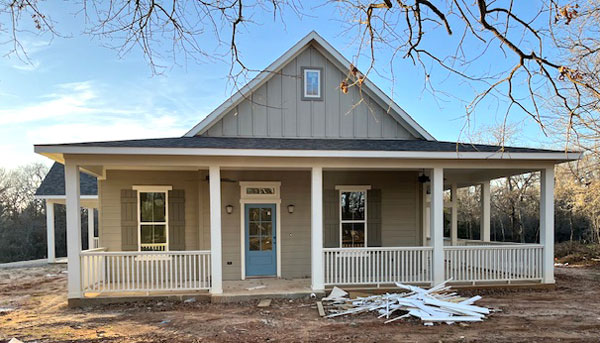
Answer: My recommendations are always going to start with the best hollies for an area. In Wise County and in beds near a house the list would include dwarf yaupon, Carissa, dwarf Chinese, dwarf Burford and maybe as large as Willowleaf where there were no windows. At corners you could use yaupon holly in tree form, or for drama, Warren’s Red possumhaw, even though it’s deciduous. Nandinas are good, as are the various abelias. I would probably not use standard abelia (too large), and I would personally not use one of the highly variegated types just due to the heat and intense sun. Sea Green juniper would be attractive in limited numbers, and I’d use some of the Petite series of crape myrtles in the fronts of one of the beds for summertime color. I would have purple wintercreeper euonymus as my groundcover. It would be attractive summer and winter against the color of your lovely home. Find a nursery you like a lot and let their designer work with you on a plan. As you recall from the landscape school, drawing up a landscape plan takes a good bit of time, but it really pays off in the long run. The one suggestion I would have (just a personal opinion) is to avoid ornamental grasses as substitutes for shrubs. Too many people make that substitution only to find that the grasses are brown 5 months out of the year and that many of them die out after a couple of years. Your beds should be fairly wide (5-8 ft. or wider) to be in scale with the rural setting.
